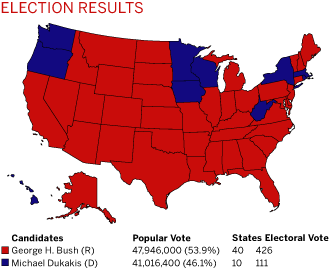1988 Bush VS. Dukakis
"Revolving Door"
Transcript
The Living Room Candidate
"Revolving Door," Bush, 1988
[TEXT: THE DUKAKIS FURLOUGH PROGRAM]
MALE NARRATOR: As Governor Michael Dukakis vetoed mandatory sentences for drug dealers he vetoed the death penalty. His revolving door prison policy gave weekend furloughs to first degree murderers not eligible for parole.
[TEXT: 268 ESCAPED]
MALE NARRATOR: While out, many committed other crimes like kidnapping and rape, and...
MALE NARRATOR [and TEXT]: Many are still at large.
MALE NARRATOR: Now Michael Dukakis says he wants to do for America what he's done for Massachusetts. America can't afford that risk.
Credits
"Revolving Door," Bush-Quayle '88, 1988
Maker: Dennis Frankenberry and Roger Ailes
Original air date: 10/03/88
Video courtesy of the George Bush Presidential Library.
From Museum of the Moving Image, The Living Room Candidate: Presidential Campaign Commercials 1952-2012.
www.livingroomcandidate.org/commercials/1988/revolving-door (accessed December 28, 2025).
Save
| 1988 | Bush | Dukakis | Results |
Ronald Reagan—the first president since Eisenhower to serve two full terms—had presided over a renewed national optimism, but there were dark clouds on the horizon as his presidency drew to a close. The federal deficit was soaring out of control. The revelation that profits from American sales of weapons to Iran were illegally routed to the Nicaraguan contras spawned a major scandal. Wall Street was in turmoil following several insider-trading scandals and the October 1987 stock market collapse. The stage was set for one of the most bitter presidential campaigns in recent history: Vice President George Bush, who portrayed himself as the rightful heir to the Reagan revolution, versus Massachusetts Governor Michael Dukakis, who offered a traditionally Democratic vision of increased government spending on health care, child care, education, and housing. The Bush campaign used brutal television advertising to portray Dukakis as an ineffective liberal who would gut the country’s defense system and let convicted murderers out of prison. Hoping voters would dismiss the attacks as unfair, Dukakis refused to counterattack until late in the campaign. By then it was too late.
Dan Quayle for vice president
"Experienced Leadership for America’s Future"
The case of Willie Horton--an African American convicted murderer who raped a white woman and tortured her fiancé while on a weekend furlough from a Massachusetts prison--was frequently mentioned by George Bush in campaign speeches. The case was directly referred to in a
Though Bush’s negative commercials garnered most of the attention, his campaign also produced a series of strong positive ads, such as
Bush’s media campaign skillfully supplemented paid publicity (commercials) with free publicity in the form of staged photo opportunities sure to be reported as news--a technique originated by the 1984 Reagan campaign. For example, news footage of Bush receiving the endorsement of the Boston police union reinforced the law-and-order message of the furlough ads. The Bush media campaign was a model of control, supervised in all respects by veteran media consultant Roger Ailes, who also coached Bush for the debates.
Lloyd Bentsen for vice president
"The Best America Is Yet to Come"
The disarray and confusion of the Dukakis campaign was exemplified by a series of commercials known as "The Handlers." In one of these commercials,
Consultants from several ad agencies came and went throughout the run of the Dukakis campaign, and the chain of command was constantly in flux. The campaign considered more than 1,000 ad scripts during a three-month period, and the ads produced were inconsistent in style and devoted almost exclusively to defending against Bush’s attacks. There were no strong ads linking Bush to Panamanian dictator Manuel Noriega, even though Dukakis repeatedly brought up the connection in speeches and debates, or to the Iran-contra arms-for-hostages deal. Most critically, Dukakis failed to respond to the Willie Horton attack until late in the campaign, when he finally aired a counterassault called
Like Mondale in 1984, Dukakis never forged a positive identity in his ads. In his speech accepting the nomination, he had movingly described himself as the embodiment of the American dream, a son of Greek immigrants who was more in touch with the people than George Bush. Inexplicably, this message was almost completely absent from his advertising.



























